



 Nicolai
Fechin was born in 1881, in Kazan, Russia. By the age of eleven,
he was drawing designs that his father used in the construction
of altars. He enrolled in the newly formed Kazan School of
Art at the age of 13. In 1900, he tested for the Imperial
Academy of Petrograd and was accepted with honors. A major
influence was the artist/teacher Ilya Repin, but the style that
seduced him was that of Malavin, a prior instructor at the Academy
who was known for "his wide, nervous brushstroke." The
Academy was temporarily closed during the Russo-Japanese war and
Repin left and did not return. The advanced students were left
to their own devices and Fechin, probably the most accomplished
of the students, used the time to experiment and grow. He became
more fascinated with portraits. (A later self-portrait is at right.)
Nicolai
Fechin was born in 1881, in Kazan, Russia. By the age of eleven,
he was drawing designs that his father used in the construction
of altars. He enrolled in the newly formed Kazan School of
Art at the age of 13. In 1900, he tested for the Imperial
Academy of Petrograd and was accepted with honors. A major
influence was the artist/teacher Ilya Repin, but the style that
seduced him was that of Malavin, a prior instructor at the Academy
who was known for "his wide, nervous brushstroke." The
Academy was temporarily closed during the Russo-Japanese war and
Repin left and did not return. The advanced students were left
to their own devices and Fechin, probably the most accomplished
of the students, used the time to experiment and grow. He became
more fascinated with portraits. (A later self-portrait is at right.)
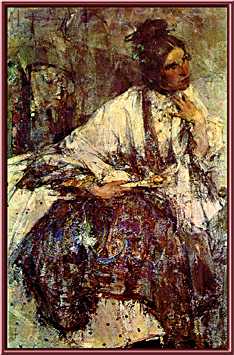 During
his last year at the Academy, he was given a position at
the Kazan School of Art as an instructor. He graduated
in 1909 with the highest grade possible and his final competitive
canvas won him the Prix de Rome, a traveling scholarship,
that allowed him to roam the artistic capitals of Europe in 1910.
This year also marked the first exhibitions of his art in America.
He sent Madame Sapojnikova (at left, now in the
San Diego Museum of Art) to an international exhibition at the
Carnegie Institute in Pittsburgh where it was purchased by W.S.
Stimmel.
During
his last year at the Academy, he was given a position at
the Kazan School of Art as an instructor. He graduated
in 1909 with the highest grade possible and his final competitive
canvas won him the Prix de Rome, a traveling scholarship,
that allowed him to roam the artistic capitals of Europe in 1910.
This year also marked the first exhibitions of his art in America.
He sent Madame Sapojnikova (at left, now in the
San Diego Museum of Art) to an international exhibition at the
Carnegie Institute in Pittsburgh where it was purchased by W.S.
Stimmel.
When Fechin returned from his travels, he reassumed his teaching position at Kazan where he taught for ten years and married the daughter of the director in 1913. He was a popular instructor. Having tasted the freedom of self-directed study, he was apt to approach instruction in a manner less demanding than the grueling exercises he was forced to complete at the Academy. He was, however, always mindful that the job of the artist was to see. Balcomb relates that in a much later class, "after watching a student transform a blonde model into an oriental on his canvas, Fechin asked, 'WHY did you come here?' "
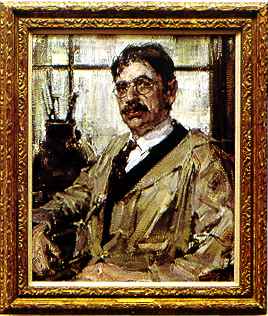 When
the Bolshevik Revolution came, many of his students achieved posts
in the new government that allowed them to offer a degree of protection
to Fechin and his wife, Alexandra, and daughter, Eya. Eventually,
though, he emigrated to the U.S. and landed in New York in 1923.
He was already well known in the States from canvases sent to
American and European exhibitions. In fact, it was American friends
and patrons, especially Stimmel, that helped him leave Russia.
The demand for his portraits was immediate and he won first prize
at the Academy in New York in 1924 and a medal at the 1926 International
Exposition in Philadelphia. (At right is a portrait of Mr.
Gorson - time frame unknown.)
When
the Bolshevik Revolution came, many of his students achieved posts
in the new government that allowed them to offer a degree of protection
to Fechin and his wife, Alexandra, and daughter, Eya. Eventually,
though, he emigrated to the U.S. and landed in New York in 1923.
He was already well known in the States from canvases sent to
American and European exhibitions. In fact, it was American friends
and patrons, especially Stimmel, that helped him leave Russia.
The demand for his portraits was immediate and he won first prize
at the Academy in New York in 1924 and a medal at the 1926 International
Exposition in Philadelphia. (At right is a portrait of Mr.
Gorson - time frame unknown.)
Fechin, who had nearly died from meningitis as a child, developed tuberculosis in New York and was advised to move to a dryer climate. He visited Taos in 1926 and moved there in 1927. The Russian prodigy was about to become part of a great Southwestern art movement. In Russia he had been chastised in the press for painting peasants, whom the Russian "patriots" considered foreigners and less-than-human. In Taos, the Pueblo Indians rekindled this love of the native peoples and their culture and heritage and their colors. The colors! Fechin had also rekindled his love of the broad, slashing palette-knife strokes of Malavin when he came to New York. In Taos the strokes and the colors combined into a style unlike any that the growing artist colony had seen.
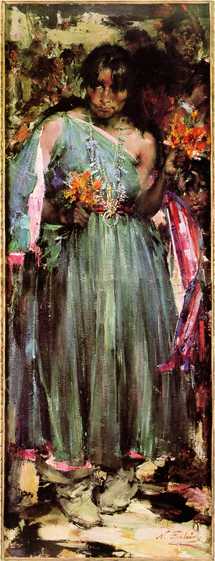 The Corn Dancer |
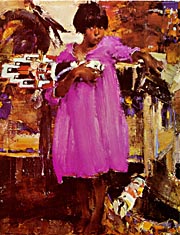 Girl in Purple Dress |
 Pietro |
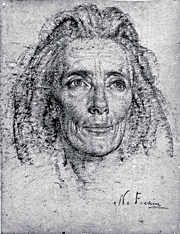 Ella Young charcoal |
 Eya's bookcase in the Taos house |
Fechin built a house in Taos. He carved the doors, the window frames, the pillars, the furniture, and designed the adobe structure. The wonderful book by his daughter, Fechin: The Builder, details much of the marvelous artistry. A sample of the strong, Russian-influenced design can be seen in the bookcase above. In 1933, the building stopped when Alexandra divorced him. He left the house and Taos and went back to New York with Eya for the winter. The house still stands. The Cowboy Hall of Fame in Oklahoma City, Oklahoma, still has a wonderful collection of his paintings and drawings.
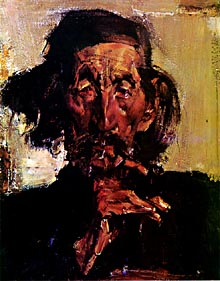 From
New York, Fechin and daughter went to Southern California which
he used as a base, teaching at the school of Earl Stendahl, a
Los Angeles art dealer, and for his travels through Mexico and
Japan and the Pacific Islands of Java and Bali. The people there
provided models and inspiration for his work as you can see from
Manuel Montona at left. He bought a spacious house
in Hollywood, but quickly sold it and moved into a studio in Santa
Monica in 1948. There he taught small groups of students and painted.
He died there in 1955.
From
New York, Fechin and daughter went to Southern California which
he used as a base, teaching at the school of Earl Stendahl, a
Los Angeles art dealer, and for his travels through Mexico and
Japan and the Pacific Islands of Java and Bali. The people there
provided models and inspiration for his work as you can see from
Manuel Montona at left. He bought a spacious house
in Hollywood, but quickly sold it and moved into a studio in Santa
Monica in 1948. There he taught small groups of students and painted.
He died there in 1955.
Fechin's fascination with faces resulted in some very powerful portraits that seemed to radiate from the eyes of the subject. The farther away from the eyes on the canvas, the looser, more abstract, more impressionistic the image became. His love of the native, the peasant and the indigenous cultures of his travels inspired his art and the combination of that love and his powerful brushstrokes shine from every canvas.
Interestingly enough, his drawings, especially those of his travels in Bali, are quite composed and finished throughout. The Ella Young charcoal above, though done earlier, shows his amazing ability to capture the spirit of the sitter. There is at least one sumptuous, large portfolio of his drawings, done in 1946, that is to die for. When we were booksellers, we sold one copy at $450 and could have sold it six times over. Another portfolio from the mid-seventies contains a color print of The Corn Dancer as well as a selection of his charcoal drawings. Also in 1946 he provided illustrations for a book, The Colorado, in the Great Rivers of America series. Otherwise the only venues for his art are the three reference books listed below, from which the vast majority of this page was taken.

To learn more about Nicolai Fechin, see:
| Nicolai Fechin | Harold McCracken, 1961 The Hammer Galleries |
| Nicolai Fechin | Mary N. Balcomb, 1975 Northland Press |
| Nicolai Fechin - Persimmon Hill vol. 8 #3 | various, 1978 The Cowboy Hall of Fame |
| Fechin: The Builder | Eya Fechin, 1982 Eya Fechin |
| The Vadeboncoeur Collection of Knowledge | Jim Vadeboncoeur, Jr. 1998. |
or visit
Fechin Art Workshop
|
Illustrations are copyright
by their respective owners. This page written, designed & © 1998 by Jim Vadeboncoeur, Jr. Updated 2011. |
